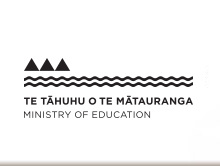Poutoti
nā Rona Lawson
He Whakarāpopototanga
Mā te poutoti ka hīkoi haere ngā tamariki. Ka hīkoi whakamua, ka hīkoi whakatemauī.
Summary
The children are learning to use stilts to walk forwards and left.
| Te momo reo tuhi Language style |
|
|---|---|
| Ētahi āhuatanga o tēnei momo reo tuhi Features of this language style |
|
I te Ākonga e Pānui Ana
During Reading
Titiro ki te uhi o mua:
1. He aha ngā mea ka kitea e koe kei te pikitia i te uhi o mua?
2. Kei te aha ngā tamariki i roto i te pikitia?
3. He aha ngā mea kei ō rātau waewae?
4. I hangaia mai ki te aha?
5. Ko wai kua hīkoi mā runga poutoti?
6. Pānuitia te taitara. He aha te hononga i waenganui i te taitara me te pikitia?
Look at the cover of the book:
1. What can you see in the picture on the front cover?
2. What are the children in the picture doing?
3. What do they have on their feet?
4. What have they been made with?
5. Who of you have used stilts?
6. Read the title. What do the title and the picture on the cover tell us about the text?
Titiro ki ngā whārangi 2 me 3:
1. Ko wai kei ēnei pikitia?
2. Kei hea rātau?
3. E aha ana ngā tamariki?
4. E aha ana te kaiako?
Look at pages 2 and 3:
1. Who are in these pictures?
2. Where are they?
3. What are the children doing?
4. What is the teacher doing?
Titiro ki ngā whārangi 4–7:
1. Ki ōu whakaaro, ka pēhea te hīkoi mā runga poutoti?
2. E hīkoi ana ngā tamariki ki hea?
3. Pēhea te tangi a ngā poutoti i ngā tamariki e hīkoi ana?
4. Whakahuatia mai ngā tangi a ngā poutoti, "Ka pī, ka pao! Ka pī, ka pao! Ka pī, ka pao!"
Look at pages 4–7:
1. What do you think it would be like to walk on stilts?
2. Where are the children walking to?
3. What sound would the stilts be making when the children are walking?
4. Say these words, "Ka pī, ka pao! Ka pī, ka pao! Ka pī, ka pao!"
Titiro ki te whārangi 8:
1. He aha ngā mea e kitea ana e koe?
2. He aha ā rātau nei mahi?
3. He aha ai?
4. He aha i whakaaro pēnā ai koe?
Look at page 8:
1. What can you see in the picture?
2. What are they doing?
3. Why?
4. What makes you think that?
I Muri i te Pānui Pukapuka
After Reading
Te Whakahihiko Hinengaro
He ngohe ēnei e pā ana ki ngā kōrero i roto i ngā pukapuka katoa, arā, Ko Wai te Toa?, Kia Tūpato Marama!, Poutoti, me Ōku Ringaringa. Ka taea e te pouako ēnei te whakamahi kia tutuki ngā whāinga whakaako me ngā whāinga ako. Mā te pouako ēnei ngohe e whakahāngai ki ngā whāinga ako me ngā hiahia o ngā ākonga.
Ia rā waiatahia te waiata Te Arapū Māori. Hoatu he kāri arapū ki ngā tamariki, mā rātou e whakaraupapa ā-arapū mai. Hei āwhina, ka whai pea i te raupapa o tētahi arapū kua tuhia ki te papatuhituhi, kua whakairihia rānei ki te pakitara.
Prompting Ideas
These are some ideas for learning which may be used in connection with the books Ko Wai te Toa?, Kia Tūpato Marama!, Poutoti, and Ōku Ringaringa, that pouako can use to help achieve their teaching purposes. These ideas can be adapted as required to suit the learning objectives and needs of the students.
Practise the song Te Arapū Māori. Give the students a set of alphabet cards to sort into alphabetical order. To help them, they could follow the alphabet written on the board or have an alphabet frieze on the wall.
Anei ētahi mahi hei āwhina i ngā ākonga kia mārama haere ki ngā ariā o te pukapuka.
1. Hangaia he poutoti ki te kēne. Mā ia ākonga āna poutoti e whakarākei. Kātahi ka whakaharatau i ngā ākonga kia hīkoi, kia kōrero i ngā kupu aronga.
2. Mahi ā-akomanga. Ka titoa mai he waiata e hāngai ana ki te kaupapa matua o te pukapuka. Ka whakaari mai i ngā mahinga ā-tinana nō roto mai i te pukapuka hei tautoko i te waiata.
Here are some activities which may help students learn the concepts in the book.
1. Make stilts from tin cans. Each student decorates his/her stilts. Students practise walking on the stilts, and using the directional vocabulary.
2. Class activity. Compose a song related to the theme of the book. Perform all the actions or activities from the book to support the song.






